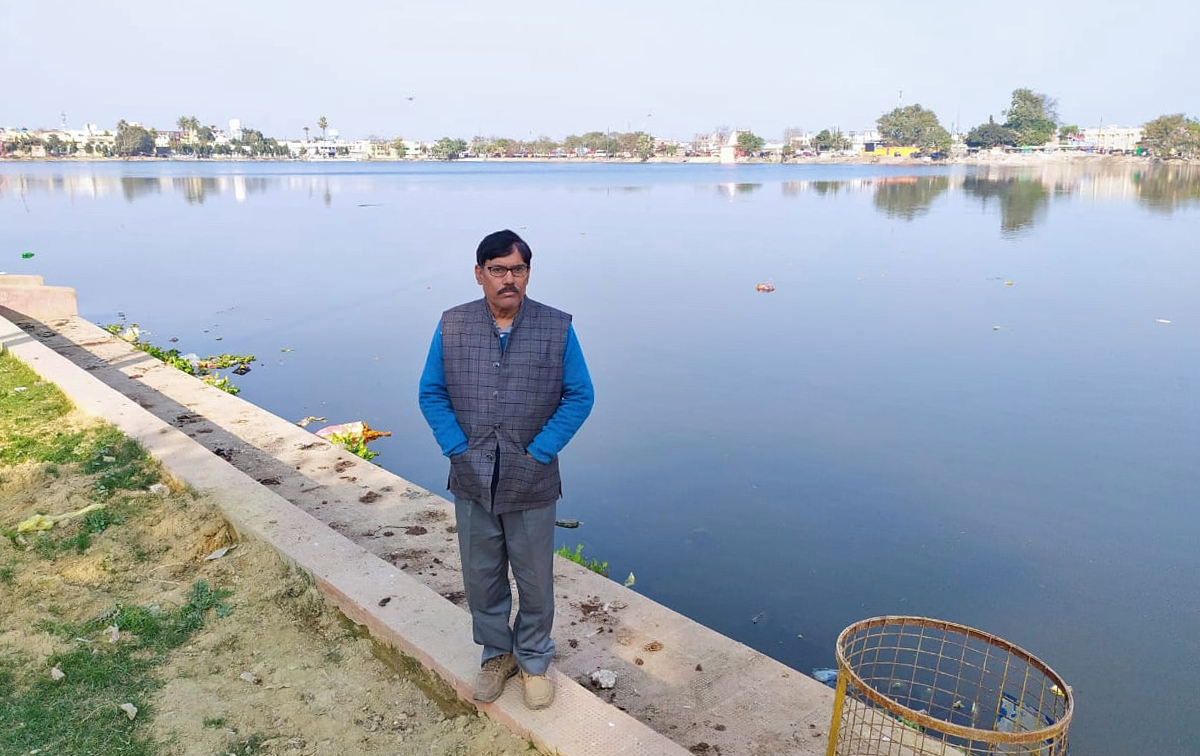
Today, the local community of Darbhanga is aware and motivated and people from different backgrounds, including a retired DRDO scientist, reputed doctors, engineers, university teachers have all joined the initiative to protect water bodies for natural water harvesting and recharging the ground water level.
People in urban as well as in rural areas of Darbhanga district have joined in peaceful protests against encroachment of water bodies and are working to revive them. “Now, people from villages and towns approach me regularly seeking help and information about how to save water bodies,” Choudhary, now in his late 50s, said.
Ponds, locally known as talab or pokhar, the common water bodies in water-rich Mithilanchal, are fast disappearing because of encroachment for constructing buildings. Even as climate change poses a threat of a water crisis, the importance of these natural sources of water is neglected.
Gajanan Mishra, a retired officer of the Water Resources Department of the government of Bihar, who has researched water bodies, said, with the number of water bodies decreasing day by day and there are no serious efforts by the government to conserve and revive them in the Mithilanchal region. Choudhary has succeeded in creating awareness about it among the people. Thanks to his years of struggle to protect ponds from encroachment in Darbhanga, some ponds were saved and some revived. Among local people he is known as a protector of ponds as he put the issue in public discourse and mobilised people to fight for the conservation of ponds, said Mishra.

The growing water crisis witnessed in recent years, including as recent as in 2018 and 2019, in Darbhanga and neighbouring districts, has compelled Choudhary to widen his campaign from saving ponds to saving and reviving “water bodies” (Jalashay Bachao Abhiyan), a new initiative kicked off this year. Choudhary’s focus now is to save water bodies (jalashay) including rivers and wetlands, locally known as chaur. He got the push in this direction from Manas Bihari Verma, a retired DRDO scientist and friend of former President A.P.J. Abdul Kalam, who has actively been supporting Choudhary from the start and encouraged him to engage with people to save all water bodies, a lifeline for survival.
According to the National Wetland Atlas, prepared by the Indian Space Research Organisation (ISRO) and the Institute of Environmental Studies and Wetland Management (IESWM), 2010, Bihar has 4.4% (measuring a total of 4,03,209 hectares) of its geographical area under wetlands. The total number of 4,416 major and 17,582 small-sized wetlands (measuring less than 2.25 ha) have been identified. Natural water bodies dominate the wetlands in the state comprising about 92% of the total wetland extent, while human-made water bodies account for about 3.5% of the total wetland area.
Water pumps and ponds go dry in a water-rich region
“Till a decade ago I was least bothered to save ponds or water bodies. It was simple – people in north Bihar, at least till early 2000, hardly expected a water crisis or depletion of groundwater. There have been plenty of water resources here since ages,” said Choudhary. But, after 2005, when handpumps started drying in Darbhanga, water shortage became a reality. Ponds used to maintain groundwater level and recharge it with natural water harvesting for centuries. “But vanishing ponds resulted in groundwater level depletion and a water crisis hit Darbhanga in summer – it was unbelievable for residents in their 60s and 70s,” said Choudhary, a social worker, working to create livelihood opportunities and microfinance for poor, and now turned conservator of water bodies.
He recalled that by 2007-08, a large number of handpumps were defunct and that forced some people to install submersibles (motor pumps), but many started facing a shortage of drinking water especially during summer.
It was a signal of a water crisis. By 2013-14, the local administration started water supply by tankers in residential localities. “This development surprised me because I witnessed similar situations during my one and half year stay at Munirka area in Delhi in 1982-83. It (the water crisis) gave me strength from inside to work to save water bodies before it is too late,” said Choudhary.

Vidyanath Jha, who teaches in a college in Darbhanga and has extensively researched wetland and makhana (fox nuts), said credit for raising a voice to save water bodies in the region goes to Choudhary. Citing studies that showed the fast disappearance of ponds in the region, he noted that there were more than 300 ponds in Darbhanga town till 1964 as per the district gazetteer, but the number went down to 213 by the early 1990s, according to research by S.H. Bazmi, Assistant Professor of Botany, Millat College, Darbhanga. Now, there are only 84 ponds left as per the official figures of the local urban body.
Ranjeev, a river activist in Bihar, said hundreds of medium and small ecologically-sensitive ponds across Bihar have vanished in the last two to three decades due to human activities and neglect, more than anything. The remaining ponds are on the verge of dying or disappearing soon if serious efforts are not made to save them. What is disturbing is that powerful people, with the silent support of local administration, are still busy encroaching ponds, mostly owned by the government, and turning them into costly pieces of land in urban pockets, said Ranjeev, adding that “Ponds have become victims of increasing human neglect and vested interest to gain something if they are dried up or filled.”

Narayan Choudhary has mobilised communities to voice against issues such as encroachments and pollution of Darbhnaga’s waterbodies to revive the region’s natural and cultural heritage. Illustration by Sheena Deviah for Mongabay.
Illegal encroachment of historical ponds
Choudhary said in the last two decades, illegal encroachers have filled ponds with waste, soil and other material, killing the ponds. With the disappearance of ponds, their ability to naturally harvest water during monsoon, will also be hit.
Three big ponds, Dighi Museum, Ganga Sagar and Harahi, that are 600 to 700 years old as well as other ponds that are about 200 years to 400 years old are also facing the threat of encroachment and dumping of garbage.
Choudhary questioned the government’s seriousness to save and revive water bodies. The government had launched a campaign in 2019 to free water bodies from encroachment and to help rainwater harvesting and groundwater conservation to tide over times of drought, flood and drinking water crisis in the state – it is now linked to the much publicised Jal Jeevan Hariyali Mission of Bihar, under which farmers get a subsidy to create ponds. This campaign is part of the Disaster Risk Reduction Roadmap 2015-2030, which mandates action for water conservation by concerned agencies. It was then claimed that the operation to conserve water bodies will focus on removing encroachment of ponds, lakes, canals, ahar and pynes (traditional water harvesting systems), drains, water drainage channels and rivers.
“The poorest of the poor have been displaced in the name of freeing water bodies from encroachment. Several ponds have been encroached upon and illegally filled in broad daylight since last year to date, in violation of guidelines of the court and the government,” said Choudhary. He said that ponds have been damaged in the name of renovation, under the mission scheme to revive them. “Most of the ponds are being turned into a deep dig hole,” he said. “Unlike other regions, Mithilanchal’s heritage is water bodies, mainly ponds, wells, network of rivers, their branches, sub-branches and wetlands. But we are not able to manage our rivers and their branches, the best natural gift.”

Mobilising the community and pushing the government to act
“It is a difficult task to save a pond due to apathy of government and local administration,” said Choudhary about his fight to protect old ponds even as illegal encroachers get away easily.
Roughly 8 to 10 ponds, mostly on the government land, were filled by illegal encroachers during the last two years, said Choudhary naming Moini pond, Baba Sagar Das pokhar, Dumduma pokhar of Darbhanga as examples. Another water body, the Makhnahi pokhar, was saved from encroachment by the local people’s resistance, he claimed.
“Our work’s result is that the local community has now started complaining against any attempt of encroachment of ponds and in some cases they protested to save ponds. It is a big relief for us that the local community have been putting resistance against encroachment of ponds either on the government or private land.” Choudhary told Mongabay-India in a telephonic conversation.
“Our approach is clear, we are committed to create awareness among the local community to save, conserve and revive water bodies.” he added. “In 2019, we submitted a brief report for renovation of traditional wells (kuaan) to cope with the water crisis based on people’s initiative of revival of traditional wells,” he said.
Now, TBA is working to prepare guidelines about renovation and conservation of traditional or cultural ponds.
Shifting focus from saving ponds to other wetlands
Due to personal health problems, Choudhary admitted that his work to save ponds was slowed down between the 2017 to 2019 period. And in 2020, the COVID-19 pandemic affected work too. But Choudhary said that his group is working towards the decision taken a year ago – to save more water bodies including rivers and wetlands.
“For this purpose we have documented some facts about the Kamla River. Its main branch and branches, locally known as Dhar. Similarly, sub-branch of Dhar is known as Nasi or Fori or Baha or Choti Kamla or by other names. Kamla river, Dhar and its branches are connected with thousands of small and big wetlands and ponds. But the situation has changed now due to the construction of embankments that had destroyed traditional water sources to ponds and wetlands and its natural management.”
There are 10 dhar (branches) of Kamla in the stretch of 45 km between Jhanjharpur to Darbhanga followed by several sub-branches. But all these were dried after the government’s Water Resources Department (WRD) encroached upon the Kamla embankment project in the name of controlling floods. “Earlier, water from these dhars would spread out into many big and small wetlands, but natural water distribution was stopped. We will now mobilise people to put pressure to start distribution of water in a controlled way to manage floods and to cope with the water crisis. If dhars will be opened, it will give life to the river and revive it with water round the year unlike only during monsoon,” said Choudhary, adding that to get rid of the drinking water crisis, revival is needed of not only chains of ponds but also river branches, its sub-branch including dhar, bahaa, nasi, fori.
Choudhary’s supporters, Verma, Mishra and Jha, are on board with the latest plan to expand their conservation work to wetlands.
Verma, who has been living in Darbhanga after retirement, said that the new Jalashay Abhiyan will work as a pressure group to force the government to initiate moves to save ponds, dhar and wetlands.
Mishra meanwhile, said, an age-old connection of river and wetland has been snapped due to the construction of embankments, roads and railways and human settlement. These are the real culprits of the dying wetlands, he said, adding that in every village of north Bihar at least 5 to 10 percent is part of the wetland, yet there is no serious move at the policy level to save wetlands. Jha also added that the economy of north Bihar in fact very much depends on its water wealth including wetlands.
This article is originally published in The Mongabay.













